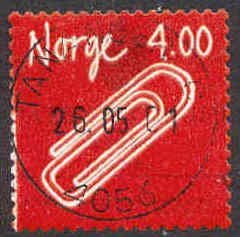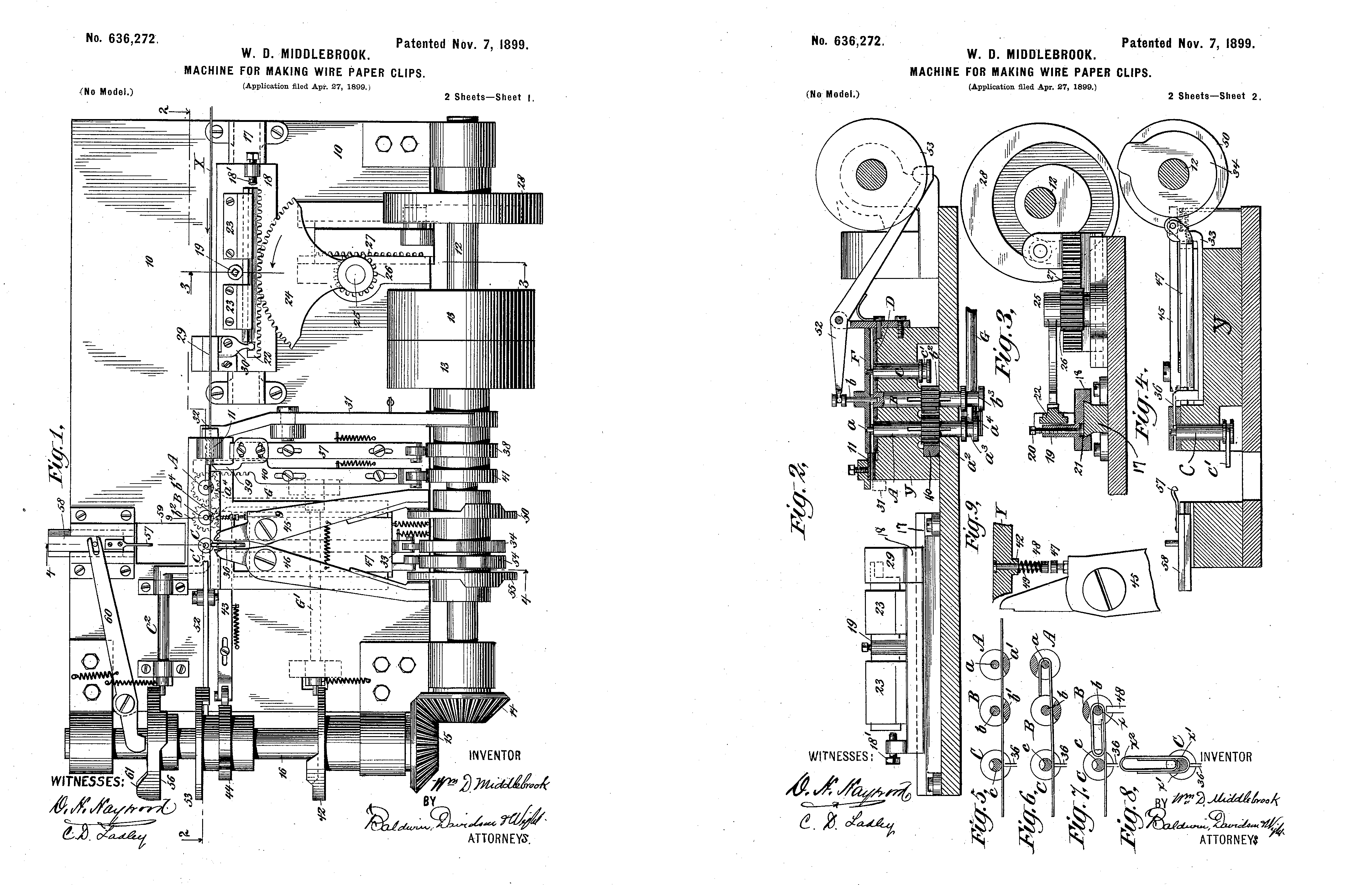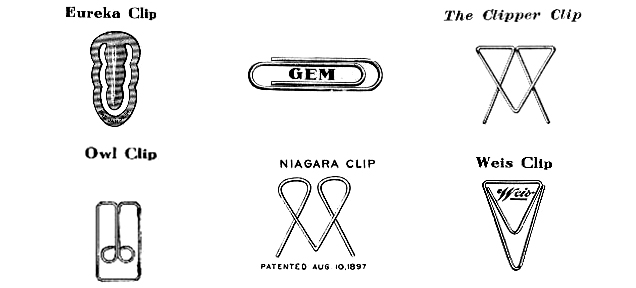When you think of paper clips, you immediately think of a specific form — the familiar round-ended, double-loop design. The wire trombone shape. But that’s only one variety of clip; the “Gem,” which gets its name from a British company called Gem Manufacturing Limited, which, even if it wasn’t directly involved with the development of the clip, was clearly able to market it well enough that the name stuck. There are many different (and some might say better) types of paper clip.
How can it be that we have no real idea of who invented it? One difficulty is that with so many different forms, so many different designs, there are just as many pretenders to the throne.
One common theory is that the paper clip was invented by a Norwegian patent clerk named Johan Vaaler in 1899. His patent application (filed in Germany in 1899 and then two years later in the United States) was for a clip made from “a spring material, such as a piece of wire, that is bent to a rectangular, triangular or otherwise shaped hoop, the end parts of which wire piece form members or tongues lying side by side in contrary directions.” One of the illustrations he included in his application did in some way resemble a Gem, but as the Early Office Museum Web site (my favourite place on the Internet) so brutally puts it, “His designs were neither first nor important.”

Vaaler’s title as the supposed father of the paper clip was given to him posthumously. And as the story grew, it accidentally managed to turn him into a folk hero of sorts in Norway. During the years of Nazi occupation, the paper clip was worn as a symbol of resistance in Norway. It was meant as a subtle sign — the binding action of the paper clip serving as a reminder that the Norwegian people were united together against the occupying forces (“we are bound together”). In the years following the war, belief that Vaaler had invented the clip began to spread. The story started appearing in Norwegian encyclopedias and soon merged with stories of the resistance to elevate the paper clip into something approaching a national symbol.
Above image: Norway’s paperclip stamp. Kyle MacDonald/Creative Commons
In 1989, the BI Business School erected a twenty-three-foot-tall paper clip in Vaaler’s honour on their Sandvika campus (this statue was later relocated to the Oslo campus). However, the statue is not actually of the same design Vaaler patented — it’s a modified Gem (one end of the clip being slightly squared). Similarly, ten years later, when Vaaler was commemorated on a Norwegian postage stamp, it was a Gem which was shown next to his picture rather than the clip he actually designed.
The Many (Other) Inventors of the Paper Clip
In the late nineteenth century, three things happened which changed that ecosystem and allowed a new species — the paper clip — to emerge.
Most obviously, for the paper clip to exist at all, you need the technology to reliably produce steel wire with the elastic properties which the clip requires in order to function successfully. Secondly, you need to be able to manufacture and sell these wire clips at a cost which is acceptable to the public. Finally, you had a burgeoning bureaucracy — a side effect of the industrialisation which enabled the first two factors. It was the birth of the office environment, and a new infrastructure was required. More paperwork necessitated some new method of organisation; the era of the paper clip was born.
From 1867 onwards, a bewildering number of patents were applied for by a host of inventors all hoping to find the best way of using a single piece of metal to attach two or more sheets of paper together. These alternative clips took many forms. There was the “Eureka” clip, a sort of segmented oval shape, cut out of a sheet of metal with a central prong to hold the papers together, patented by George Farmer in 1894; the “Utility” clip from 1895, which was similar to an old-fashioned ring pull, folded back on itself; the “Niagara,” which was basically two of Fay’s clips joined together, patented in 1897; the “Clipper,” a pointy version of the Niagara from the same year; the “Weis” clip, an equilateral triangle within an isosceles, patented in 1904; the spectacularly named “Herculean Reversible Paper Clip,” where the wire was bent into two slightly wonky isosceles triangles; the “Regal” or “Owl” clip, which sort of looked like an owl, if the owl had been raised in a rectangular cage which was too small for it and grew up deformed into a weird boxy shape; and the “Ideal” clip, a complex butterfly-shaped wire arrangement, patented in 1902. The list goes on and on: the “Rinklip,” the “Mogul,” the “Dennison,” the “Ezeon.”
Despite this period of wild experimentation, the narrow doubleloop form of the Gem has remained the most enduring paper clip design.

The first time a recognisable Gem-type clip appears in patent literature is in 1899. William Middlebrook applied for a patent (above) for a machine to automatically manufacture “wire clips for binding or securing papers in lieu of pins,” and included in the patent application is an image showing the “general shape and character” of the clips the machine manufactured. However, the Gem was actually known for at least a decade before that. Professor Henry Petroski (author of The Evolution of Useful Things) cites an 1883 edition of Arthur Penn’s The Home Library, which celebrates the Gem for its superiority over other devices for use in “binding together papers on the same subject, a bundle of letters, or pages of a manuscript.”
A Perfect Design?
Often cited as an example of “perfect” design, the Gem has been featured in exhibitions at the Museum of Modern Art in New York and the Vitra Design Museum in Germany. Emilia Terragni, one of the editors of the Phaidon Design Classics series, named the paper clip as one of her favourite objects:
Because in the paper clip you have the essence of design: you have beautiful design; you have a simple mechanism; you have something that’s never changed in a hundred years — it’s still the same. It’s still very functional and everybody uses it.
But . . . is the Gem paper clip really as perfect as so many claim? If the clip is used to hold together a particularly thick document, it can become distorted and bent out of shape. In many ways, its functional qualities have become overstated as the simplicity of its design has become cherished.
The claim that the design has not changed in a hundred years is also questionable. It’s true that the paper clips available today are very similar to those illustrated in advertisements from the 1890s. But there are also lots of paper clips that share many of the characteristics of the Gem, but which have been given subtle tweaks here and there. You can get “lipped” clips, where the bottom of the inner loop is raised, to allow the clip to slide on more easily (although this idea has been around since George McGill’s patent of 1903). Another variation is the “Gothic” clip, designed by Henry Lankenau in 1934 — whereas the classic Gem has rounded Romanesque ends, the “Gothic” clip has a squared top, allowing it to lie flush with the top of the paper, and a pointed bottom, making it easier to attach. “Corrugated” clips provide extra friction, preventing the clips from sliding off so easily. The differences are slight, but changes have been made. From a recent trip to Ryman, I’d say that the paper clips were split about 50/50 between pure Gem-like clips and modified versions.
So why is there this prevailing belief that the Gem represents perfection, when the reality is that it’s actually not quite as good as everyone thinks?
The belief seems to come from the fact that on almost every level the Gem is more than satisfactory. It’s not perfect, but it’s good enough: 8/10 all around. When a tweak is made, the new design performs better in some ways but then worse in others. The “lip” makes it easier to slide on, but can make a pile of documents bulkier. The “Gothic” clip is also easier to use, but the pointed end can scratch or tear papers. The “corrugated” clip is less likely to slide off accidentally, but it’s then more fiddly to remove. The Gem isn’t perfect, and people will continue to try to improve it, but the struggle will be to find a new design that is as balanced as the Gem.
Adapted from The Perfection of the Paper Clip by James Ward. Copyright © 2014 by James Ward. Originally published as Adventures in Stationery in Great Britain by Profile Books Ltd. Reprinted by permission of Touchstone/Simon & Schuster.
Picture: Early Office Museum
